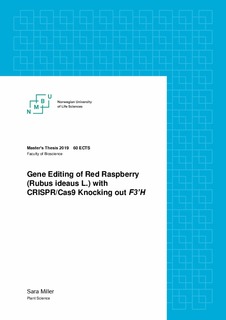| dc.contributor.advisor | Hvoslef-Eide, Trine | |
| dc.contributor.advisor | Alsheikh, Muath | |
| dc.contributor.author | Miller, Sara | |
| dc.date.accessioned | 2019-08-16T08:05:47Z | |
| dc.date.available | 2019-08-16T08:05:47Z | |
| dc.date.issued | 2019 | |
| dc.identifier.uri | http://hdl.handle.net/11250/2608590 | |
| dc.description.abstract | Breeding new improved crop varieties is a lengthy process that can take many years. With climate change and more rapidly changing environmental conditions, it becomes even more important to develop new varieties quickly. Gene editing presents a useful tool to achieve this. The relatively new gene editing method CRISPR/Cas9 is simple, cost-effective and above all more precise than most other methods. Due to its novelty there is no protocol for CRISPR/Cas9 for many plants. The aim of this thesis is to develop such a protocol for rasp-berry which is an economically important crop, especially in the northern parts of Europe. As a proof of concept, the gene F3’H, an important gene for synthesis of the main anthocyanin cyanidin in the berries of raspberry, was knocked out.
Several different delivery methods for CRISPR/Cas9 have been used in this thesis. Two types of Agrobacterium-mediated transformation have been tested: transformation of in-vitro ex-plants to regenerate entire transformed pants and agroinfiltration of greenhouse-grown plants as a quick method to test the designed CRISPR/Cas9 constructs. Biolistic transformation by gold particle bombardment of callus was also tested. The focus however was on obtaining transformed plants by Agrobacterium-mediated transformation, by far most the common transformation method for plants.
Plants were regenerated only after the Agrobacterium-mediated transformation. These plants were likely transformed, but the plants were too small to verify this through a PCR screening when the experiment had to end due to the submission date for this thesis. It turned out that agroinfiltration, as it is used for tobacco, is not a suitable transformation method for raspberry. Neither were any plants regenerated from the bombarded callus. However, it could be verified that there were changes in the genome of some callus cells within the target region of the CRISPR/Cas9 constructs. | nb_NO |
| dc.description.sponsorship | Graminor | nb_NO |
| dc.language.iso | eng | nb_NO |
| dc.publisher | Norwegian University of Life Sciences, Ås | nb_NO |
| dc.rights | Attribution-NonCommercial-NoDerivatives 4.0 Internasjonal | * |
| dc.rights.uri | http://creativecommons.org/licenses/by-nc-nd/4.0/deed.no | * |
| dc.subject | CRISPR/Cas9 | nb_NO |
| dc.subject | Agrobacterium-mediated transformation | nb_NO |
| dc.subject | Anthocyanin pathway | nb_NO |
| dc.title | Gene editing of red raspberry (Rubus idaeus L.) with CRISPR/Cas9 knocking out F3'H | nb_NO |
| dc.title.alternative | Genredigering av bringebær (Rubus ideaeus L.) ved hjelp av CPISPR/Cas9 utslag av genet F3'H | nb_NO |
| dc.type | Master thesis | nb_NO |
| dc.subject.nsi | VDP::Agriculture and fishery disciplines: 900 | nb_NO |
| dc.subject.nsi | VDP::Mathematics and natural science: 400 | nb_NO |
| dc.description.localcode | M-PV | nb_NO |

